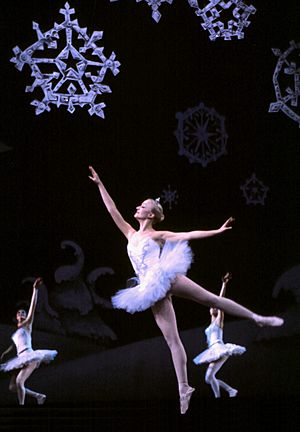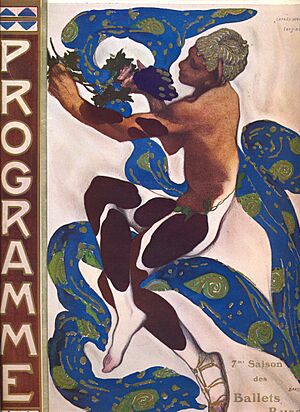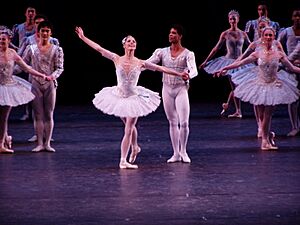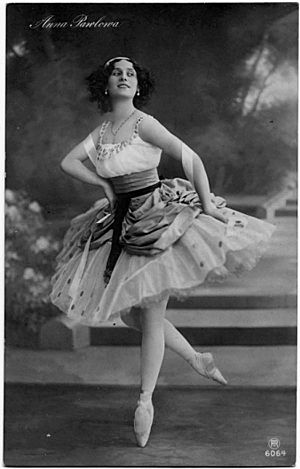Ballet facts for kids
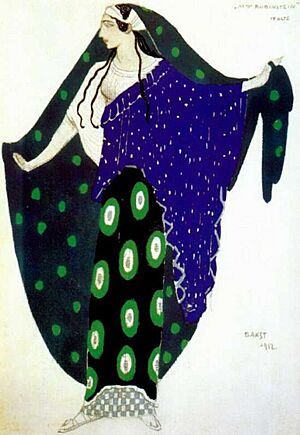
Ballet is a special kind of dance. It is performed by dancers who have had a lot of training. These dancers usually work for a dance company. They perform their shows in theatres. The first mention of ballet was by a person named Domenico da Piacenza. He lived in the early 14th century.
Ballet often tells a story without words. The story is shown through dance and mime (acting without speaking). Ballet is a way to express feelings and ideas. It brings a story to life in a new way for the audience. Creating the dance steps is called choreography. Dancers learn the choreography from a trainer. This trainer is called a ballet master or mistress. Ballet is always performed with music. Often, the music is written just for that ballet. The Nutcracker is a very popular example of a ballet.
Contents
History of Ballet
How Ballet Started
Ballet began with big shows in the Renaissance period. These shows were like today's huge concerts. They used all kinds of performance art. These early Italian ballets became more developed in France. One famous show was Le Ballet Comique de la Reine. It was performed in Paris in 1581. Balthazar de Beaujoyeux, a violin player, put on the show. It was danced by people who were not professionals. The royal family watched from one end of the hall. Other people watched from balconies on three sides. Poetry and songs were also part of the dances.
The main ideas of classical ballet came from the court of King Louis XIV. This was in France during the 17th century. King Louis XIV even got his nickname, the 'Sun King', from a role he danced in a ballet. He started the first ballet company. It was called the Ballet de l'Opera de Paris. Many ballets at his court were created by Jean-Baptiste Lully. He was a composer. Pierre Beauchamp was a choreographer. Also, the writer Molière created something new. It was called the comedie-ballet.
Modern Ballet Begins
In the early 1800s, ballet technique was made clearer. A dancer named Carlo Blasis from Naples wrote down the steps. His dance classes were four hours long. They were known for being very tough training. 'Romantic ballet' became popular in France. This was in the first half of the 19th century.
A more athletic style of ballet grew in Imperial Russia. This happened in the late 1800s. The ballet company there performed at the Mariinsky Theatre. This theatre is in St. Petersburg. Three famous ballets by Pyotr Ilyich Tchaikovsky came from this time. They are Swan Lake, The Sleeping Beauty, and The Nutcracker.
The next big step was the Diaghilev ballet. Diaghilev was a great impresario. This means he was a showman. In 1909, he started Les Ballets Russes de Sergei Diaghilev. Many people think it was the best ballet company ever. Its success was amazing. Its ballets were revolutionary. Its artists were electrifying. When it appeared in Paris before the First World War, it started a ballet boom around the world.
His dancers included the famous Vaslav Nijinsky and Tamara Karsavina. Other great dancers were Anna Pavlova, Danilova, and Spessivtseva. His choreographers included Mikhail Fokine, Léonide Massine, and George Balanchine. Composers like Igor Stravinsky, Sergei Prokofiev, Maurice Ravel, and Claude Debussy wrote music. Set designers like Pablo Picasso, Paul Cézanne, Henri Matisse, Utrillo, Léon Bakst, and Georges Braque created the scenery. The ballets they made changed ballet history forever.
Later in the 20th century, new ballet companies started. These were in English-speaking countries. The Royal Ballet in London was one of them. In New York, a company called the Ballet Russe de Monte Carlo was founded. It performed from 1938 to 1962.
Ballet Technique
Technique is how well a dancer can perform the steps. It's their physical skill. Specific ways of training technique are named after the ballet master or mistress who created them. For example, there is the Vaganova method. It is named after Agrippina Vaganova. The Balanchine method is named after George Balanchine. The Cecchetti method is named after Enrico Cecchetti.
Ballet Costumes
Ballet costumes are very important in the world of ballet. They are often the only thing left from a show. They help us imagine what the performance looked like.
Early Costumes
Ballet started in the Renaissance in France and Italy. The fancy clothes worn at court became the first ballet costumes. Ballet costumes have been around since the early 1400s. People used cotton and silk mixed with flax. This was woven into see-through fabric. This created beautiful ballet costumes.
17th Century Costumes
During the 1600s, different fabrics and designs were used. This made ballet costumes even more amazing and eye-catching. Women still wore court dresses during this time. Silks, satins, and fabrics embroidered with real gold and jewels were used. This made ballet costumes even more decorative. Women's costumes were also heavy. They had skirts that reached their knees. This made it hard for them to move and make big gestures.
18th Century Costumes
In the 1700s, stage costumes were still like court clothes. But they changed over time. This was mostly thanks to a French dancer named Jean-Georges Noverre. He wanted to make ballet more modern. His ideas are in his book Lettres sur la danse et les ballets (1760). Noverre said that ballet should tell a story through movement. The movements should show how the characters feel. Before Noverre, ballets were big shows. They focused on fancy costumes and scenery. They did not focus on the dancers' feelings or movements.
European ballet was centered at the Paris Opera. During this time, skirts were a few inches off the ground. This was shorter than in the Renaissance. Over time, costumes got more designs and colors. Flowers, ruffles, ribbons, and lace made the style very feminine. Soft colors like lemon, peach, pink, and light green were popular.
19th Century Costumes
In the early 1800s, costumes became tighter. Dancers wore floral crowns, corsages, and jewels. The ideas of Romanticism were seen in women's stage costumes. Costumes became much tighter. Corsets were used to show off a ballerina's curves. Jewels and sparkly costumes became very popular.
20th Century Costumes
In the 1900s, ballet costumes were influenced by Russian ballet again. Ballerina skirts became knee-length tutus. This was so audiences could see the dancers' pointe work. It also showed off their ballet technique. During this time, costumes focused on the importance of the dancers' work. Colors used on stage became much brighter. Designers used colors like red, orange, and yellow. This helped create visual expression when dancers performed.
Some Famous Ballet Dancers
- Margot Fonteyn
- Tamara Karsavina
- Mikhail Baryshnikov
- Anna Pavlova
- Rudolf Nureyev
- George Balanchine
- Vaslav Nijinsky
- Misty Copeland
- Natalia Makarova
- Diana Vishneva
- Carlos Acosta
Related Pages
Images for kids
-
Classical bell tutus in The Ballet Class by Degas, 1874
-
Louis XIV as Apollo in the Ballet Royal de la Nuit (1653)
-
Marie Sallé, classical ballet dancer
-
Carlotta Grisi, the original Giselle, 1841, wearing the romantic tutu
-
Alexandra Danilova and Serge Lifar, Apollon Musagète, 1928
-
Suzanne Farrell and George Balanchine dancing in a segment of "Don Quixote" at New York State Theater
-
Maggie Gripenberg (in the middle) performing at the Finnish National Theatre in 1916.
See also
 In Spanish: Ballet para niños
In Spanish: Ballet para niños


